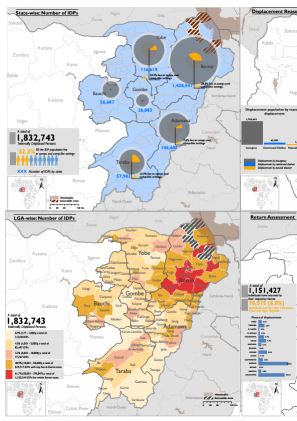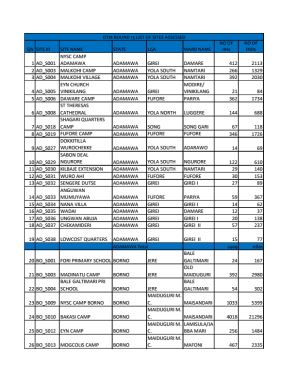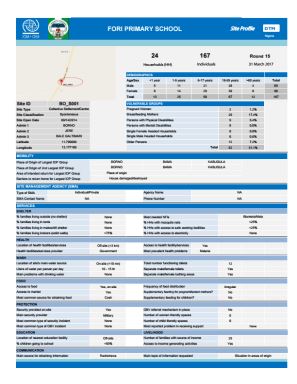-
Countries
-
Data and Analysis
-
Special Focus
-
Crisis Responses
Nigeria
Nigeria
Desplazados internos rastreados
Movimientos de desplazamiento
3,340,000
IDMC 2023
Ronda de recopilación de datos
Sobre Nigeria
The escalation of violence between all parties in north-eastern Nigeria since 2014 has resulted in mass displacement and deprivation in the states of Adamawa, Bauchi, Borno, Gombe, Taraba and Yobe. To better understand the scope of displacement and assess the needs of affected populations, IOM has been implementing its Displacement Tracking Matrix (DTM) programme starting July 2014, in collaboration with the National Emergency Management Agency (NEMA) and State Emergency Management Agencies (SEMAs). The activities of the DTM project, which consist of conducting baseline assessments and registration for IDPs living in camps and host communities, are currently being carried out in Adamawa, Bauchi, Borno, Gombe, Taraba and Yobe.
The information collected will contribute to the provision of a comprehensive profile of the IDP population in Nigeria which will be shared with all relevant stakeholders and will contribute towards enabling the government of Nigeria and humanitarian partners identify the needs of Nigeria's displaced population and develop interventions for providing IDPs necessary assistance.
Contacto
DTM Nigeria
DTMNigeria@iom.int
Current Donors
- ECHO
- BHA
- Canada
Para obtener resultados de búsqueda más avanzados, vaya a la Página de búsqueda avanzada de informes
Nigeria — Displacement Dashboard Round 16 (May 2017)
DTM has identified 1,884,331 displaced individuals. 35% of IDPs dwell in camps or camp-like settings. 65% of all individuals are in host community settings. 79.5% are women and children. 28.3% are children under five years. 69% of people surveyed cited food as an unmet need.
Nigeria — Emergency Tracking Tool Report 11 (16—24 April 2017)
This DTM Emergency Tracking Tool (ETT) has been deployed to track and provide up-to-date information on sudden displacement and other population movements in Bama, Chibok, Damboa, Dikwa, Gwoza, Jere, Kaga, Kala Balge, Konduga, Mafa, Monguno and Ngala.
Nigeria — Emergency Tracking Tool Report 10 (10—16 April 2017)
Included in this Emergency Tracking Tool (ETT) snapshot are Gwoza, Ngala, Kala-Balge, Chibok, Damboa and Askira/ Uba. 1,119 displaced individuals were recorded in Gwoza and, respectively, 133 in Ngala, 144 in Kala/ Balge, 874 in Bama, 143 in Askira Uba, 77 in Damboa and 33 in Chibok.
Nigeria — Dalori II Flash Report (13 April 2017)
On 12 April 2017 at about 9:10 pm, suspected Boko Haram insurgents attacked the military station situated behind Dalori II (250 Housing Estate Camp), less than 2 kilometers from the camp.
Apr 13 2017
Nigeria — Dalori II Flash Report (13 April 2017)
Nigeria — Emergency Tracking Tool Report 9 (4—10 April 2017)
The DTM Emergency Tracking Tool (ETT) was deployed to track and provide up-to-date information on sudden displacement and other population movements in Askira Uba, Gwoza, Ngala, Kala-Balge, Kaga, Bama, Dikwa and Chibok.
Nigeria — Emergency Tracking Tool Report 8 (27 March — 4 April 2017)
Included in this Emergency Tracking Tool (ETT) snapshot are Bama, Chibok, Damboa, Dikwa, Gwoza, Kala/Balge, Ngala and Monguno. 1,397 Individuals (357 households (HH)) arrived at Camps in Bama.
Nigeria — Displacement Report 15 (March 2017)
The report covers the period of 15 February to 31 March 2017 and includes six most-affected states of Adamawa, Bauchi, Borno, Gombe, Taraba and Yobe.
Mar 31 2017
Nigeria — Displacement Report 15 (March 2017)
Nigeria — Displacement Dashboard 15 (March 2017)
As of 31 March 2017, DTM has identified 1,832,743 IDPs (326,010 households) across Adamawa, Bauchi, Borno, Gombe, Taraba, and Yobe states.
Mar 31 2017
Nigeria — Displacement Dashboard 15 (March 2017)
Nigeria — Site Assessment Dashboard 15 (March 2017)
During the reporting period DTM identified 206 camps and camp-like settings (formal and informal camps) housing 567, 795 individuals (108,399 households). Most camps were found in Borno state with 238,751 informal as well as 299,722 formal camps.
Nigeria — Returnee Dashboard 15 (15 February — 31 March 2017)
A total of 1,151,427 individuals have returned to their respective homes. 78,575 (6.8%) individuals returned from Cameroon, Chad and Niger Republic. This dashboard highlights areas with high return populations.
Nigeria — List of Displacement Sites Assessed 15 (15 February — 31 March 2017)
This is a list of all Round 15 sites including site number, site name, state local government area (LGA), ward name with the respective number of households and individuals.
Nigeria — List of Wards Assessed 15 (15 February — 31 March 2017)
This is a list of all round 15 wards including state, local government area (LGA), ward and the number of households/ individuals.
Nigeria — Adamawa Site Profiles 15 (15 February — 31 March 2017)
This is a compilation of all site profiles in Adamawa identified in Round 15 assessments.
Nigeria — Borno Site Profiles 15 (March 2017)
This is a compilation of all Round 15 Borno Site profiles.
Mar 31 2017
Nigeria — Borno Site Profiles 15 (March 2017)
Nigeria — Taraba Site Profiles 15 (15—31 March 2017)
This is a compilation of all round 15 Taraba site profiles.
Nigeria — Yobe Site Profiles 15 (15 February — 31 March 2017)
This is a compilation of all Round 15 Yobe site profiles.
Nigeria — Emergency Tracking Tool Report 7 (21—27 March 2017)
DTM emergency tracking was deployed in Nigeria to track and provide up-to-date information on sudden displacement and other population movements in Dikwa, Jere, Kala/Bagle, Ngala, Nganzai and Bama.
Nigeria — Emergency Tracking Tool Report 6 (15—21 March 2017)
This snapshot includes information on numbers, displacement reasons and needs from IDPs in five local government areas (LGAs): Gwoza, Kala Balge, Bama, Ngala and Dikwa. The largest numbers of IDPs are in Kala Balge LGA: there are currently 3,070 IDPs (614 households) due to military operations.
Nigeria — Emergency Tracking Tool Report 5 (10—14 March 2017)
Emergency tracking for: Bama (335 arrivals), Moguno (41 arrivals), Mobbar (1,050 arrivals), Kala/Balge (195 arrivals), Dikwa (911 arrivals).
Nigeria — Emergency Tracking Tool Report 4 (24 February—9 March 2017)
This snapshot includes information on numbers, displacement reasons and needs from IDPs in eight local government areas (LGAs). 3,945 IDPs (734 households) were displaced due to recent attacks in Chibok. The largest numbers are in the main Chibok town (Garu, Likama and Whumtaku wards).
Nigeria — Emergency Tracking Tool Report 3 (18—26 Februrary 2017)
A snapshot of the movement of people from: Barna (246 arrivals), Dikwa (234 arrivals), Kala/Balge (320 arrivals), Mobbar, Kodunga, Gwoza (892 arrivals), Monguno (54 arrivals), Kukawa (370 arrivals), Yola South (42 arrivals) and Mub (60 arrivals).
Nigeria — Biometric Registration Report Northeastern Nigeria (13—19 February 2017)
IOM's biometric registration project is currently being implemented in three states in northeastern Nigeria. In total, 340,734 individuals have been registered in Borno, 143,496 in Adamawa and 21,201 in Yobe.
Nigeria — Emergency Tracking Tool Report 2 (13—19 February 2017)
This snapshot provides information on location, movement and needs of displacement in Pulka, Bama, Dikwa, Kala/Balge, Mobbar,Konduga and Gwoza during the covered period.
Nigeria — Returnee Dashboard 14 (19 December 2016 — 25 January 2017)
This dashboard is a map indicating the number of returnees per LGA. 1,099,509 returnees returned to Adamawa, Borno and Yobe States. 64,151 (5.8%) were Nigerian refugees from Chad and Cameroon. The map indicates return areas, inaccessible areas, water boundaries and state boundaries.
Pagination
Para obtener resultados de búsqueda más avanzados, vaya a la Página de búsqueda avanzada de conjuntos de datos
Pagination
- First page
- Previous page
- 1
- 2
- 3
- 4
- 5
- 6
- 7
- 8
Pagination
- First page
- Previous page
- 1
- 2
- 3
- 4
- 5
- 6
- 7


























